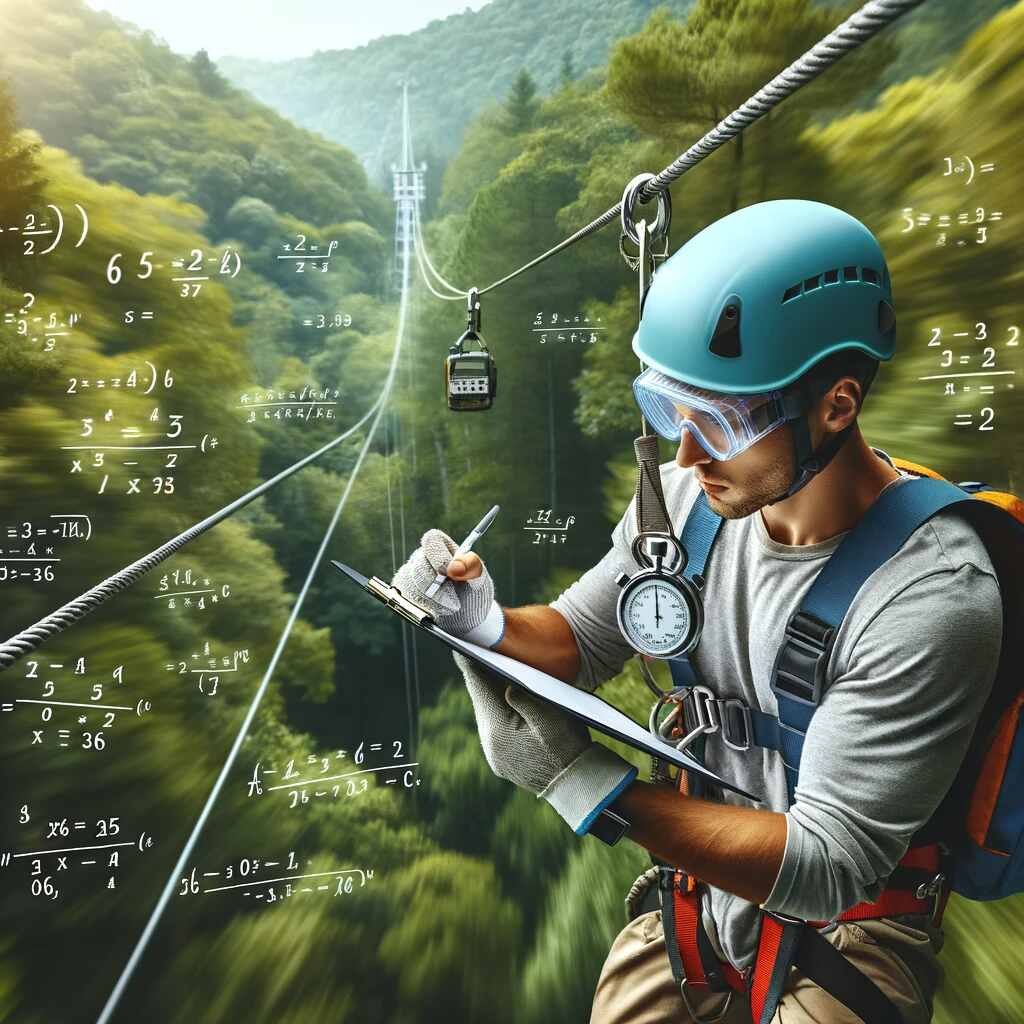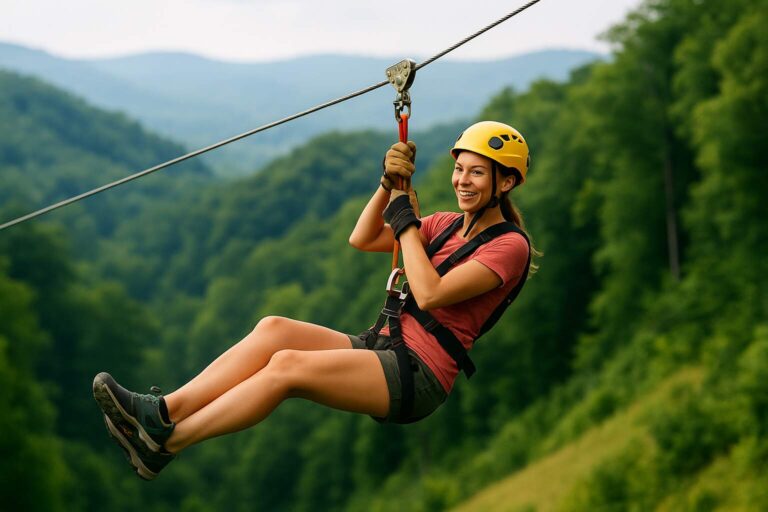Ziplining is an exhilarating outdoor activity that has gained popularity among adventure seekers around the world. Whether you’re soaring through dense forests or over breathtaking landscapes, the speed at which you traverse a zipline can significantly enhance your experience. To ensure a thrilling yet safe ziplining adventure, understanding zipline speed and how to calculate it is essential.
In this comprehensive guide, we will delve into the world of zipline speed calculation, covering everything from the basic principles to advanced techniques. Whether you’re a zipline enthusiast looking to optimize your experience or a zipline operator aiming to provide the best possible adventure for your customers, this article is tailored to satisfy your need “zipline speed calculator.”
The Fundamental Concepts of Ziplining
Before diving into zipline speed calculations, it’s important to grasp the fundamental concepts of ziplining:
Zipline Setup: A typical zipline consists of a cable stretched between two anchor points, with a harness and pulley system for the rider. The rider is attached to the pulley, which glides along the cable.
Gravity and Tension: The force of gravity propels the rider down the zipline, while tension in the cable provides the resistance necessary for the ride. Balancing these forces determines the zipline’s speed.
Gradient: The slope or gradient of the zipline, which represents the angle of descent, plays a crucial role in determining the speed. Steeper gradients typically result in higher speeds.
Factors Affecting Zipline Speed
Several factors influence zipline speed. Understanding these factors is essential for accurate speed calculations:
Cable Length: Longer ziplines tend to have higher speeds due to the increased time for gravity to act on the rider. Conversely, shorter ziplines result in lower speeds.
Cable Tension: Tension in the zipline cable can be adjusted to control speed. Higher tension levels provide more resistance, slowing down the rider, while lower tension allows for increased speed.
Rider Weight: Heavier riders experience greater gravitational force, leading to higher speeds. Lighter riders will have slower descents.
Slope Angle: As mentioned earlier, the steeper the slope angle, the faster the zipline speed. A flatter zipline will lead to slower speeds.
Wind Resistance: Wind can affect zipline speed, particularly for longer ziplines. Strong headwinds can slow down the rider, while tailwinds may increase speed.
Friction and Surface Quality: The condition of the cable and pulley system, as well as the presence of lubrication, can impact speed. A well-maintained zipline will generally result in smoother and faster rides.
Zipline Speed Calculation Formulas
Now, let’s explore the mathematics behind zipline speed calculation. There are two main approaches: a simple formula for basic calculations and a more advanced formula that considers multiple factors.
Simple Zipline Speed Calculation
The basic formula for calculating zipline speed is as follows:
Speed (S) = √(2 * g * h)
Where:
- S represents the zipline speed in meters per second (m/s).
- g is the acceleration due to gravity, approximately 9.81 m/s².
- h is the vertical height difference between the starting and ending points of the zipline in meters (m).
This formula provides a straightforward way to estimate zipline speed, assuming a constant gravitational force and neglecting factors like rider weight and cable tension. While it offers a rough estimate, it may not be entirely accurate for more complex ziplines.
Advanced Zipline Speed Calculation
For a more accurate calculation that accounts for additional factors, we can use a more advanced formula:
Speed (S) = √((2 * g * h) / (1 + (k * v²)))
Where:
- S represents the zipline speed in meters per second (m/s).
- g is the acceleration due to gravity, approximately 9.81 m/s².
- h is the vertical height difference between the starting and ending points of the zipline in meters (m).
- k is a constant that accounts for air resistance and other factors (typically around 0.2 to 0.4).
- v is the velocity of the zipline rider in meters per second (m/s). It’s important to note that v is an iterative variable and must be calculated iteratively.
This advanced formula provides a more accurate estimation of zipline speed by considering factors like rider weight, wind resistance, and cable tension. Calculating the velocity (v) requires iteration, making it more complex but yielding a more precise result.
Safety Considerations
Safety should always be a top priority when engaging in ziplining activities. While calculating zipline speed is important for optimizing the experience, it must not compromise safety. Here are some safety considerations to keep in mind:
Weight Limits: Zipline operators should establish weight limits for riders to ensure safe operation. Riders should adhere to these limits to prevent accidents caused by excessive speed.
Regular Maintenance: Regular inspection and maintenance of zipline cables, pulleys, and harnesses are essential for safe operation. Frayed cables or worn-out equipment can lead to accidents.
Protective Gear: Riders should always wear appropriate protective gear, including helmets and harnesses, to minimize the risk of injury.
Safety Briefings: Zipline operators should provide thorough safety briefings to riders, including instructions on body positioning and braking techniques.
Emergency Procedures: Operators should have clear emergency procedures in place, including methods for stopping riders in case of an emergency.
Professional Training: Zipline operators and guides should receive professional training to ensure they are equipped to handle various situations and emergencies.
Tips for Controlling Zipline Speed
While zipline speed can be calculated, it can also be controlled to provide riders with a customized experience. Here are some tips for zipline operators to control speed:
Cable Tension Adjustment: Adjusting the tension in the zipline cable can control speed. Increasing tension slows riders down, while reducing tension allows for higher speeds.
Brake Systems: Implementing brake systems at the end of the zipline can help slow riders down safely. These systems can be manually operated by guides or triggered automatically.
Weight Distribution: Group riders of similar weights together to ensure consistent speeds and experiences.
Wind Screens: Installing wind screens or barriers can help mitigate the impact of strong winds, maintaining a more controlled speed.
Cable Lubrication: Regularly lubricate the zipline cable to reduce friction and enhance the rider’s experience.
Zipline Speed Calculator Tools
To simplify the process of zipline speed calculation, there are various online tools and software applications available. These tools take into account the factors mentioned earlier and provide accurate speed estimates for different zipline configurations. Some popular zipline speed calculator tools include:
Zipline Design Software: Specialized zipline design software often includes built-in speed calculation features. These tools allow operators to input various parameters to determine the optimal zipline speed.
Online Zipline Speed Calculators: Several websites offer online calculators that prompt users to input key variables such as cable length, rider weight, and slope angle to calculate zipline speed.
Spreadsheet Templates: For those who prefer a more customizable approach, spreadsheet templates can be created using spreadsheet software like Microsoft Excel or Google Sheets. These templates can incorporate both the simple and advanced speed calculation formulas.
Conclusion
Ziplining is a thrilling adventure that relies on the perfect balance of gravity, tension, and rider dynamics. Calculating and controlling zipline speed is essential to ensure a safe and enjoyable experience for riders. Whether you’re an operator looking to fine-tune your zipline setup or an enthusiast seeking to understand the science behind the ride, mastering the art of zipline speed calculation is key to maximizing the fun and safety of this adrenaline-pumping activity.
By considering the basic principles, factors affecting speed, and the mathematical formulas involved, you can confidently navigate the world of ziplining and provide unforgettable experiences for riders. Remember that while speed is important, safety should always be the top priority. With the right knowledge and tools, you can create ziplines that deliver both excitement and security, making every descent a memorable adventure.








